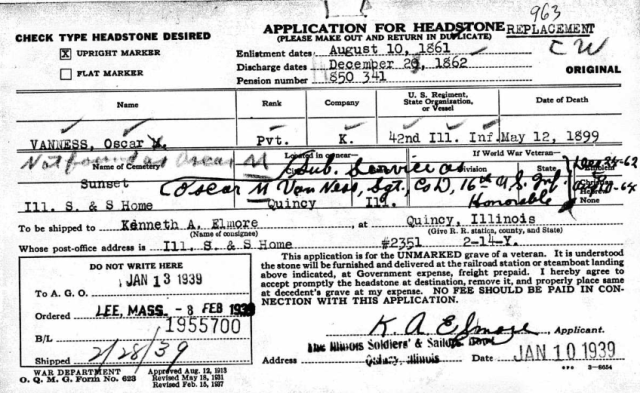In 1857, Stokley Evans (my 4x great grandfather), and his two older twin brothers Alex and Floyd made their way from Fentress County, Tennessee to Clinton County, Kentucky to purchase a number of hogs from the three Ferguson brothers; Ben, Jim, and Champ. At this time, the now infamous Champ Ferguson was a farmer with a wife and daughter who was known to have violent tendencies.
Floyd Evans left a note for payment with the Fergusons, they had arranged a meeting in Albany to complete the transaction. When the Fergusons went to collect the money, Alex told the men that Floyd had skipped town with the money. Champ and another man filed a lawsuit against Floyd.
As time went on and Floyd still had not been seen or heard from, Champ got it in his head that the Evans’ were pulling an elaborate hoax to get out of debt. The Ferguson’s decided that whenever Stokley or Alex were around that they would take their horse as payment. They caught Alex in Clinton County and stole his horse.
Floyd returned in late June or early July 1858, secured his debt, and the lawsuit Champ had filed was dropped by the Clinton County Court on July 5, 1858. Around the same time, Alex filed charges against Champ for his horse thievery.
The Evans brothers were furious with Champ for stealing their horses and trying to claim it was a repossession by a creditor when Floyd was the one who owed the money. Alex and Stokley began speaking out publicly, which the paranoid Champ Ferguson took as threats on his life.
Champ and the Evans brothers attended a camp meeting in Fentress County on Lick Creek on August 12, 1858. Ferguson decided to leave, mounted his horse, and realized the Evans brothers along with other men were hurling rocks at him. As he rode away, he realized the men had also mounted their horses and were chasing him down. Champ, realizing that his young mare could not outrun the other horses, dismounted and took off on foot. Floyd Evans came up, still throwing rocks and Ferguson returned them in his direction. Then, Sheriff Jim Reed approached Champ intending on arresting him for his horse thievery. A scuffle between the two occurred, Champ stabbed him until the sheriff fell and died. He then attempted to stab Floyd, but changed his mind.
Fentress County Justice of Peace James Zachary, Sr. (my 5x gg-father) charged Champ for killing Jim Reed. During his time in jail, a deal was made with Champ, he would be released if he agreed to help the confederacy. This agreement altered the course of the war for my ancestors and others in Fentress, TN and Clinton, KY.
On April 1, 1862 Champ encountered 16 year old Fount Zachary near Champ’s mother in law’s home. Fount had been put in charge of keeping an eye on the main road leading into Tennessee for the Union Home Guards, he was armed, but surrendered his weapon willingly. When asked his name, he gave it, and Champ immediately shot Fount down from his horse. He then walked over and stabbed the boy through the heart. Fount was the nephew of James Zachary, Sr., the man who had charged Champ for killing the constable Jim Reed. The Zachary’s were also some of the most outspoken and influential unionists in Fentress County.
The Nashville Daily Union made mention of the incident, but changed the details to make Champ sound more monstrous:
“A promising little boy, 12 years old, by the name of Zachary was taken from his sickbed and cut open by Champ Ferguson,” – Daily Nashville Union
On June 2nd 1862, Champ payed a visit to the farm of James Zachary, Sr. He chased Zachary through the orchards while his daughter Esther stood on the porch. She heard the shots that ended her father’s life and Champ’s accomplices telling him, “not to shoot a dead man.” Ferguson came inside the home and took a pair of the magistrate’s spurs with him. Esther Zachary Jackson later stated that her father’s head looked like “jelly”. Stokley Evans was apparently accompanying Ferguson as a prisoner for this murder. She said during the trail that Lafayette Allen was the first to fire at her father.
“On the morning on which old Mr. Tabor was killed, while we were taking breakfast, Ferguson sat down by me and asked me what old man Zachery’s sons said about their father being killed. I told him they said they intended to kill the fellow who did it. He wanted to know who they thought did it, and I told him, ‘Fayette Allen’. He said they need not blame Allen with it, that he was the man that killed him and was responsible for it.” – the testimony of William Thrasher
Stokley Evans was killed in front of his young children by troops of some sort on August 3, 1862. His wife Louisa Poor Evans had died a year prior during childbirth. Their orphaned children were sent to live with Stokley’s sister, Amanda Evans Beaty, in Clintion County, KY. As no one ever confessed to killing Stokley, it is unlikely that his murderer will be identified.
My 4x great grandfather, John “Jackie” Zachary hid in Hale’s Mill in Pickett County, TN and killed a C.S.A. soldier named Lafayette Allen on September 15 1862.
New Year’s Day 1863, Champ killed another 4x great grandfather of mine, Peter Allen Zachary along with his brother James Allen Zachary in Russel County, Kentucky in what Champ called the “most desperate struggle of his life“. He never asked them to surrender.
My Zachary and Evans lines were united by the marriage of William Osker Zachary (grandson of Peter Allen Zachary & great grandson of James Zachary) and Oda Cansada Evans (granddaughter of Stokley Evans) who were married January 31, 1901 in the same area of Tennessee.






 Oscar M. Vanness was the older brother of my 4x Great Grandfather, Lewis Vanness Sr. He was born 1834 in New Jersey to Euphemia Dey and Aaron Vanness. The Vanness family (including Aaron, Euphemia, Oscar, Lewis, Anna, and boarder Jabez Tucker) settled in Afton, Dekalb, Illinois.
Oscar M. Vanness was the older brother of my 4x Great Grandfather, Lewis Vanness Sr. He was born 1834 in New Jersey to Euphemia Dey and Aaron Vanness. The Vanness family (including Aaron, Euphemia, Oscar, Lewis, Anna, and boarder Jabez Tucker) settled in Afton, Dekalb, Illinois.


